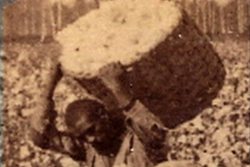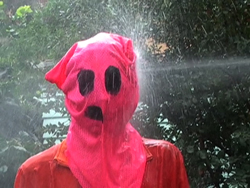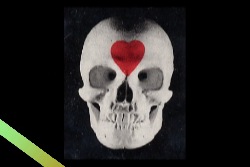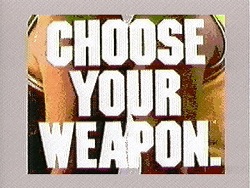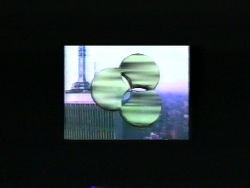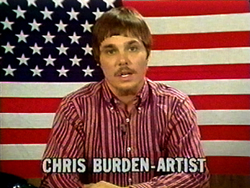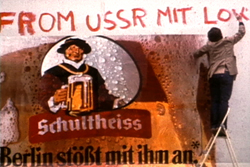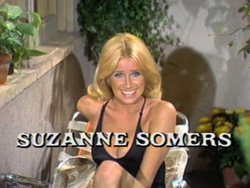
EAI @ THE NY ART BOOK FAIR 2009
EAI @ THE NY ART BOOK FAIR 2009
P.S.1 Contemporary Art Center
22-25 Jackson Ave at the intersection of 46th Ave
Long Island City, NY 11101
Friday & Saturday, October 2-3, 11 am - 7 pm
Sunday, October 4, 11 am - 5 pm
EAI @ THE NY ART BOOK FAIR 2009
P.S.1 Contemporary Art Center
22-25 Jackson Ave at the intersection of 46th Ave
Long Island City, NY 11101
Friday & Saturday, October 2-3, 11 am - 7 pm
Sunday, October 4, 11 am - 5 pm
EAI @ THE NY ART BOOK FAIR 2009
P.S.1 Contemporary Art Center
22-25 Jackson Ave at the intersection of 46th Ave
Long Island City, NY 11101
Friday & Saturday, October 2-3, 11 am - 7 pm
Sunday, October 4, 11 am - 5 pm
Works
Trecartin describes this work as a "narrative video short that takes place inside and outside of an e-mail." Trecartin, wearing his signature make-up, jumps back and forth between male and female roles. Totally self-absorbed and equipped with vestigial attention spans, the stylized characters are constantly on the phone or online. Their e-mail exchanges and Internet searches are channeled into bright animations that intersect with "real world" locations; the story moves from person to person like a browser surfing through Web pages.
With Blue Moon Over, Weiner extends his text-based works into a digital realm, positing aphorisms and epigrammatic phrases that investigate language, acquisition and desire. Employing a visual system that suggests flowcharts, horizon lines and diagrams, Blue Moon Over is structured as a series of seamlessly animated sequences of drawings and text fragments. Through subtle manipulations, Weiner engages in linguistic tricks and metamorphoses that visually manifest his conceptual inquiries.
WARNING: This work contains throbbing light. Should not be viewed by individuals with epilepsy or seizure disorders.
Ken Jacobs writes: "An antique stereograph image of cotton-pickers, computer-animated to present the scene in an active depth even to single-eyed viewers. Silent, mournful, brief."Produced by Graham at the Banff Centre in Canada, Graham's new video draws on nearly twenty years' worth of footage shot in the bizarre yet familiar arena of the shopping mall. The resulting work provides a coldly beautiful view of mall culture: its architecture, its consumer public and its unique aesthetic world. This work also provides a corollary to Graham's own prodigious writings and projects on the public spaces of corporate capitalism.
Commissioned by VideoGram International, Ltd., for a videodisc of music by Jimi Hendrix, Fire! uses the stylized visuals and pacing of a music video to critique the representational economies of sexuality and consumerism. Translating the psychedelic fervor of the Hendrix song into a...
In KK Queens Survey, Linzy appears as a New York artist/diva who submits to an outrageous telephone survey on her artistic and personal practices. Debra Singer writes in Artforum, "Linzy's blistering lampoon of art world power dynamics typifies Linzy's trademark mixture of raunchy humor, campy theatricality, sexual intrigue and poignant social commentary."
In this live performance for Paper Tiger Television's public-access cable program in New York, Rosler deconstructs the messages in Vogue and its advertising. Rosler looks at the institutional slants of the magazine industry and the fashion industry's reliance on sweatshops.
At first glance, Masters of None could be the home video of a family of neon-pink hooded figures, passing the time with charades, television, and Jiffy Pop on the stove. As in All Together Now, Masters has no dialogue or clear narrative arc, and while the domestic activities seem everyday, they...
In her new work, Thornton confronts the economic and cultural transformation of contemporary China, evoking the spectacle of capitalism run amok. Creating a layered landscape of alienation and dislocation, Thornton shoots from her window of the Jin Jiang Hotel in Shanghai, the site of Mao's 1972 meeting with Nixon, and revisits her 1983 film Adynata, itself an exploration of Orientalism and the Other.
Rejected or Unused Clips... purports to be a collection of unused video and audio clips left over from the artist's other works. Interlacing voice-over and sound with the sorts of graphic imagery that could belong equally to advertisements, corporate reels, amateur home pages, and video games, Price takes on religious and scientific discourse, the history of experimental cinema, the interrelation of culture and technology, and the social naturalization of violence. At the same time, however, this index of material at once discarded and made useful, with its claim to a formal structure based on "importance," provokes the question of how much its themes and messages are actually intended to cohere and communicate.
Slogans is a visual deconstruction of advertising slogans, a literal and metaphorical illustration of the disintegration and loss of meaning of information in the contemporary "media landscape." Appropriating text from a series of familiar print advertisements — "Choose Your Weapon," "Play to...
This video examines the sorts of propaganda that a corporation might distribute internally to communicate an over-arching mandate or vision to its workers in order to boost morale. Bernadette Corporation slyly turns the notion inside out, yielding a document that at once subverts and expresses the form.
The TV Commercials is a recent compilation of Burden's four legendary television interventions, which date from 1973 to 1977. For each of these conceptual projects, Burden purchased commercial time on broadcast television and aired his own subversive "ads." Included are TV Ad: Through the Night Softly; Poem for L.A.; Chris Burden Promo, and Full Financial Disclosure.
This newly assembled work is a rare document of a 1976 Matta-Clark performance in Berlin. The piece begins with the following statement: "In 1976, as part of the Akademie der Kunst and Berliner Festwochen exhibition 'Soho in Berlin,' Gordon Matta-Clark went to Germany with the intention of blowing up a section of the Berlin Wall. Dissuaded by friends from such a suicidal action, the result was the following performance." The film records Matta-Clark as he stencils 'Made in America' on the Wall, affixes commercial advertisements over graffiti, and has a run-in with the police.
In Timewarp Experiment, Murata applies a simple temporal manipulation to a piece of found footage, to uncanny effect. Digitally slowing the opening credit sequence from the 1970s' TV sitcom Three's Company, Murata creates a strange, hypnotic flow of movements and arrested gestures that unfold in unnatural time.
Touch Cinema is a document of VALIE EXPORT's famous street performance, in which the public was invited to touch her inside a curtained box attached to the artist's upper torso. The work is a witty and confrontational comment on the objectification of women's bodies.


